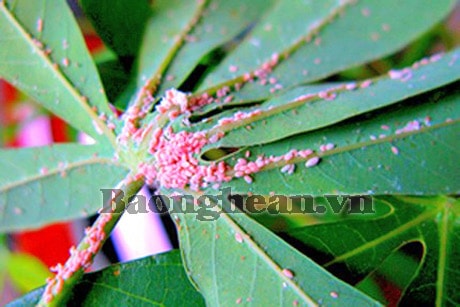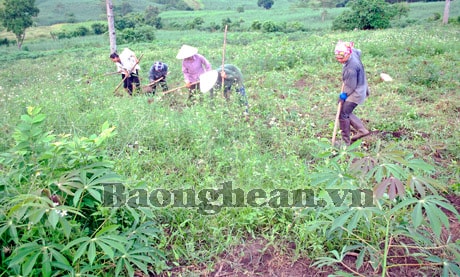Prevention of pink mealybugs that damage cassava
(Baonghean)Pink mealybug is considered a quarantined object, first discovered in Tay Ninh province in June 2012 with an infected area of 75 hectares, common rate of 10-15%, high rate of 25-50%, locally up to 100% of plants were damaged. Assessing the trend of damage level and spreading speed of pink mealybug, scientists warned that the aphid will spread and cause widespread damage in many cassava growing areas of the country, seriously affecting cassava yield and quality.
1. Identification features
Eggs: Eggs are oblong and rectangular, newly laid are slightly yellow in color and later turn pinkish yellow, in egg sacs covered with fine hairs and located at the posterior end of the female. Egg size: length: 0.30-0.75mm; width: 0.15-0.30mm.

Pink mealybugs on cassava plants. Photo: Xuan Hoang
Young bed bugs: Young bed bugs are pink and have 3 instars. The first instar's antennae have 6 segments, the next instars have 9 segments.
Adult bed bugs: Females are egg-shaped, pink, covered with a white waxy layer, slightly protruding eyes, well-developed legs of equal size. The body parts are clearly divided, the body segments carry very short white waxy fibers. The head antennae usually have 9 segments. Adult female bed bugs are wingless, male have wings.
Pink cassava mealybugs develop strongly in the dry season and months with low rainfall (<30mm). In environmental temperature conditions of about 28 degrees Celsius, the development time from egg to adult laying the first egg is about 33 days (life cycle). Each adult female can lay 300-500 eggs.

Farmers in Giai Xuan commune (Tan Ky) take care of cassava. Photo: Xuan Hoang
During their life, the pink mealybug lives in symbiosis with some species of ants. Like other species of false mealybugs, the pink mealybug has the ability to reproduce asexually. The adult female does not need to mate to lay eggs and the eggs still hatch.
Pink mealybugs exist on all parts of the cassava plant (roots, stems, leaves, growing points). Newly hatched mealybugs are easily blown away by the wind, spread through cuttings, dispersed by wind, drifted by water sources, and stick to the bodies of animals, humans, tools, and means of transport...
Pink mealybugs attack the growing points of cassava plants, causing stunted shoots. The main shoots are damaged, resulting in dwarfing of the plants and crooked stems. In high density infections, cassava plants can lose all their leaves, reducing the yield of cassava tubers by 80-84%.
In addition to cassava as the main host, pink mealybugs also damage some wild host plants: ginseng, sedge, poinsettia, rubber trees...
2. Measures to control pink mealybugs
Carefully check the origin of cassava shipments and cuttings before importing them into Vietnam. If pink mealybug infestation is detected, immediately handle the infected shipment and cuttings according to regulations. It is necessary to strictly control and monitor the cassava growth process in the field to detect new mealybug nests early, conduct thorough destruction, isolate the infected area, collect infected plants, apply measures such as burning, spraying pesticides on the entire infected area, etc.
2.2. Cultivation and mechanical measures
- Prepare the soil well and let it dry for 2 weeks before planting cassava.
- Prepare clean cuttings, not infected with pink mealybugs.
- Soak the cuttings in hot water at 500C for 5-10 minutes.
- Cut, dig and move part of the infested plant out of the production field, and destroy the diseased plant.
- Clean up weeds and cassava roots after harvest to avoid some of the remaining pink mealybugs in the cassava field.
- Soak cassava cuttings in pesticide solution for 30 minutes before planting in the field.
- Use some chemicals to spray aphids such as: Thiamethoxam, Dinotefuran, Nitenpyram, Imidacloprid. Use according to the recommended concentration with a solution of 600 liters/ha.
- Use predators such as: Ladybugs, pintails, predatory spiders, hymenoptera insects such as: Plesiochrysa ramburi...
- Using parasitic wasp species: Anagyrus lopezi, this is a bee species that is bred and released into the fields, with an efficiency of 80%, ensuring the ecological environment and public health.
- Using parasitic fungi: Beauveria bassiana is sprayed on the field to parasitize aphids.
Nguyen Huy Khanh (Plant Protection Center of Zone 4)






